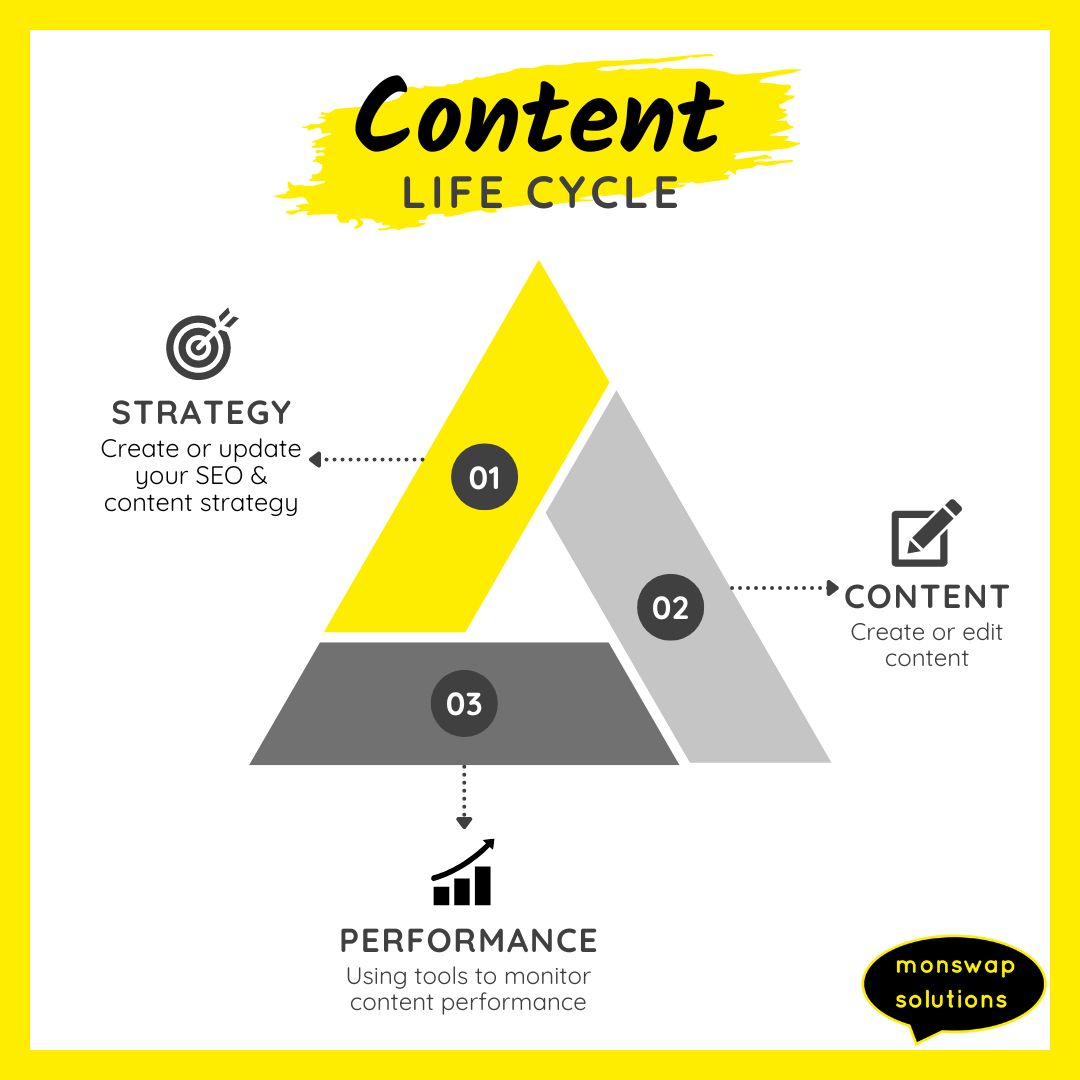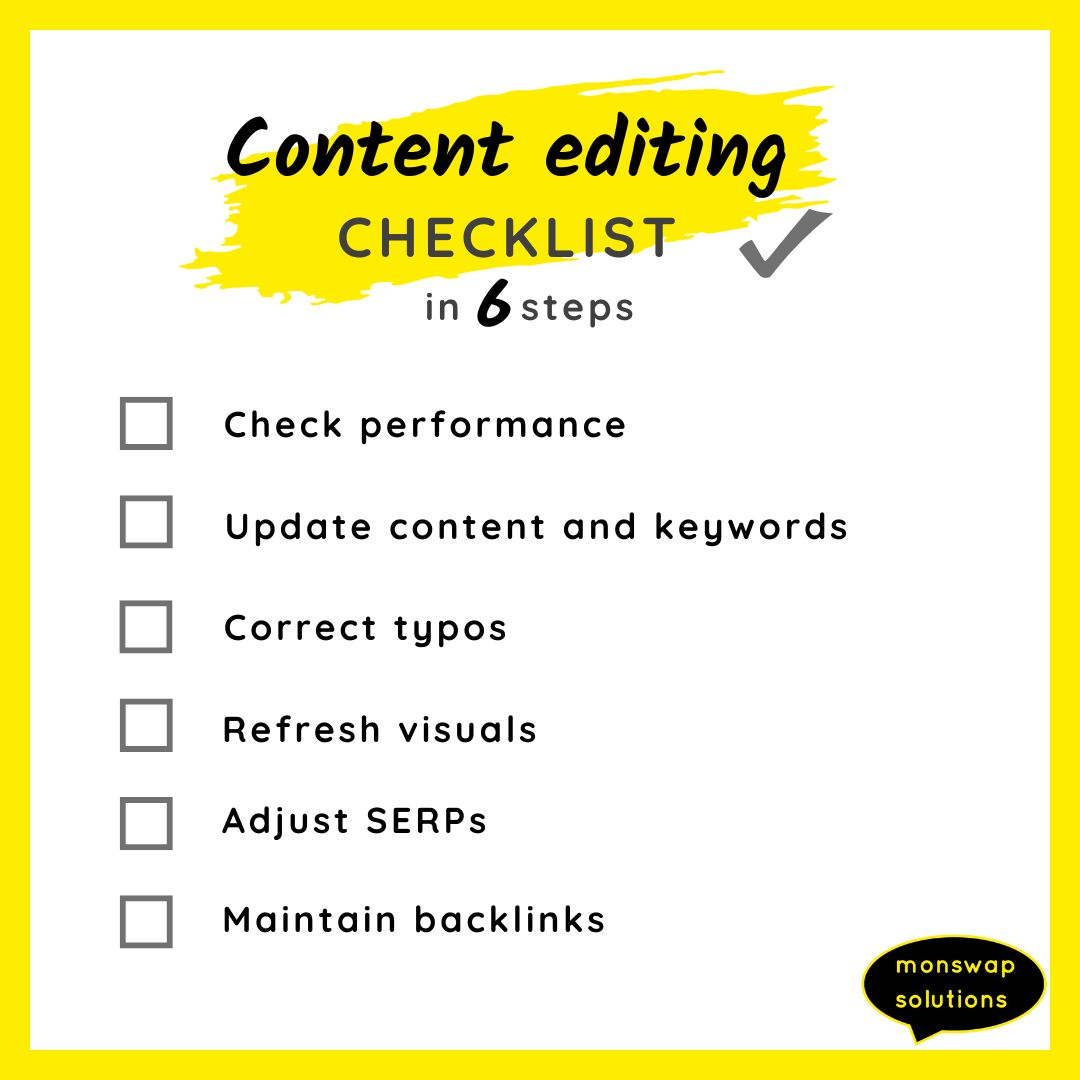As a German SEO copywriter, I am convinced that regular content editing is crucial if you want your website ranking at the top of Google search results in the long term. In this blog post, I explain why it is so important to keep SEO content up to date, which tools will help you to measure and optimise the performance of your website content, and give you a checklist of tasks which you can complete yourself. Finally, I’ll answer some popular questions about content maintenance. Let’s go!
What is (SEO) content editing?
Content editing means that you regularly review, update, and improve all content on your website.
This includes SEO copy on landing pages as well as blog posts, FAQs, product descriptions, images, charts, and more.
Is your SEO content working hard enough? Or is there still room for improvement?
This editing process involves not just about correcting typos, but also adding new information and removing outdated content. Also, with SEO content, it is especially critical that it is up to date as far as the latest algorithm updates by search engines is concerned.
The aim is to make this content even more relevant for your customers as well as for search engines on your target market. In case of German content, this would be Germany, Switzerland, and Austria.

3 reasons, why is it important to update website content
1) Boost SEO through topicality
Search engines like Google love copy that is up to date. “Fresh” content signals Google that you are actively working on your website – and that your content is becoming increasingly relevant.
Regular content maintenance therefore helps you to get to – and stay – at the top of the search results.
Studies show that websites with regularly updated content generate up to 30 % more traffic.
2) User friendliness
Your users also like up-to-date content: nobody wants to see outdated information.
With well-kept content, you improve the user experience and will (almost certainly) increase the time spent on your site.
In addition: Satisfied users tend to come back and are more likely to share your content. Which in turn contributes to point 1).
3) Reputation
Have you ever shaken your head because the last post that you saw on a company blog was about the 2016 Christmas party? (Or is that just me? #ContentNerd)
Can we agree that outdated content is simply embarrassing and slightly unprofessional?
If you’ve nodded twice now, this is the third good reason to update your content regularly.
What content maintenance has to do with your SEO & content strategy
A well thought-out SEO strategy is the be-all and end-all for ranking at the top of Google. ( I will tell you exactly how to create such a strategy over on my blog []).
Why should you keep churning out new content when you already wrote an excellent piece of copy 1, 2, 3 years ago?
Exactly.
Revising is faster than rewriting.
Next, update the keywords, check the backlinks and, if necessary, add new ones.
It is that easy to supplement your content editorial plan with revised and polished content.
Clever, isn’t it?

6 SEO tools that measure content performance
All of these tools can help you evaluate the effectiveness of your content and are a great base for copy editing.
Free tools
With Google Analytics or Matomo (if you like to be GDPR-compliant), you can measure exactly which content is well received by your (German-speaking) customers – and which is not. Time spent on site and bounce rate quickly show you where you need to start updating your content.
Google Search Console gives you insights into search engine performance and helps you to identify and fix technical problems.
Paid tools
My favourite feature on Ubersuggest is its website analysis. This SEO tool gives you a great overview of which pages need improvement: 404 errors, missing or outdated, etc. Super practical for quick “repairs” and edits. Plus, you can even export the data to a spreadsheet.
As a German SEO copywriter, I frequently use a German tool called Sistrix to create detailed visibility and competition analyses that help me to create SEO strategies or to continuously adapt and optimise them. I particularly like the feature that allows me to monitor pages and create personalised SEO reportings. This way you really know on a monthly basis exactly how hard your content is working for you – and where you should focus your content editing efforts.
To get an initial overview before starting content editing, I like to use the app SiteProfiler from the Mangools SEO suite. SERPChecker is my go-to tool for checking and revising SERPs (Search Engine Result Pages). And the LinkMiner tool is great for checking and updating backlinks.
Content editing: 6 effective steps
Let me take you through my personal process of content editing.

1) Check performance
Use one of the SEO tools mentioned above to measure how your content is performing. Analyse the data and adjust your content accordingly.
For example, if a blog post generates little traffic or continues to rank on page 2, check and add the keywords before improving the copy so that Google can start to rank it better.
2) Update content and adjust keywords
Routinely check whether the content on your website is still up to date. Add new information or keywords and remove outdated sections.
For example, enrich SEO copy such as blog posts or landing pages with new data or charts and add new insights to existing FAQs.
3) Correct typos
Spelling and other grammar mistakes can appear unprofessional and affect the trust of your customers – especially in Germany, Austria, and Switzerland. Use tools like Grammarly or work with a native German copywriter to quickly find and erase typos.
4) Refresh visuals
Of course, you also want your content to be found through the image search. To make this happen, replace stock photos with images from the latest photo shoot, keep updating infographics or create new videos. After all, content editing also means that the quality of your visuals is constantly improving.
5) Adjust SERPs
SERPs requirements, i.e. SEO titles and meta descriptions, change from time to time. Adjust their length and structure accordingly when updating content.
Note: Always check the SERPs of your top competitors beforehand. This is the only way to make your own SERPs better than those of your competitors.
6) Maintain backlinks
Backlinks are another important ranking factor. Therefore, regularly check whether your existing backlinks are still active and relevant – and keep generating new ones.
Partnerships with interesting co-operation partners, e.g. for writing guest posts, can help you.
What customers ask me about content editing…
How often should I update my content?
Firstly: There is no hard and fast rule. As a rule of thumb, I recommend checking all content on your website about once a year – and editing it if necessary.
If you have more free capacity and frequent changes make sense: Go for it!
Basically, you can say that the higher the keyword difficulty (KD) of the focus keyword and the stronger the competition, the more frequently you should edit the content.
According to a study by Siege Media, content with less competitive keywords is updated on average every 1.74 years, while copy with highly sought-after keywords are revised much more frequently (to be precise: every 0.87 years).
Which tools are best for content editing?
I use Sistrix, Ubersuggest, and Mangools as a base for updating content. Free tools such as Google Analytics or Matomo and Google Search Console can also help you to determine which SEO copy you should optimise – and how.
By the way: You can also use the Yoast SEO plugin to, for example, optimise your SERPs or identify missing (internal) links.
Can I handle content editing myself or should I hire a professional?
That depends on your knowledge and the time you have available. If you want to work intensively on SEO and content editing, you can do a lot of the work yourself. In this case, it is best to follow your SEO strategy as well as your editorial plan.
If you lack the time or expertise, it can make sense to hire an SEO copywriter like me to ensure that your content is always up to date.
I hope this blog post has helped you to work out where to start with updating your own website content. If you need help with editing and optimising your German content for SEO: I am happy to help.
Simply reach out and let’s work together to keep your website successful for the German market.
What is AI content editing?
AI content editing refers to the use of artificial intelligence technologies to improve, enhance, or modify digital content. This content can include copy, images, videos, audio, and more.
While not a fan of letting AI do all the work and loosing control over strategy and quality, I appreciate its help when updating existing SEO content.
I often use AI for editing tasks such as
- initial grammar and spell checking
- suggesting improvements to the tone, clarity, and readability of text
- suggesting additional content elements such as CTA-Buttons, new sections or links
- create summaries or teasers
In my experience, using AI tools makes my content editing work faster, which in turn saves my customers money. And it does increase the content quality.




